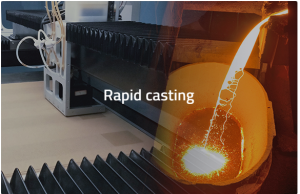3D Printing-the next Leap for Conventional Sand Casting
Sand casting, the most widely used casting process, utilizes expendable sand molds to form complex on of a kind metal part. Although this process has history dating back entire eras, its grotesque production times and intricate mold designs were laborious and expensive. But 3D printing was around the corner to change the way with traditional ways by providing more accuracy and such quicker operation with would save some penny costly and serve the purpose well,
Streamlining Mold Making
Rapid Prototype Development
One of the biggest benefits when using 3D printing for Sand Casting is the significant reduction in time to produce molds. Traditional mold-making takes weeks to complete, and is extremely labor intensive, Halofoot said.- REUTERS Significantly reducing the time to create sand molds with 3D printing. Being able to do so more quickly allows faster iterations which is very helpful in development, particularly during prototyping when there are often many evaluable designs.
Enhanced Design Flexibility
Complex Geometries simply;;=...complex geometries with ease.
The ability to produce intricate geometries, which conventional sand casting methods would struggle or fail to achieve, is something where 3D printing also comes out on top. This technology effectively makes it possible to generate chicken-legs or other complexity internal features and undercuts with little need for any additional, cost-prohibitive tooling like cores. For instance, 3D printed molds can have intricate cooling channels designed for specific parts, cooling the casted parts more effectively, improving its quality and mechanical properties by changing the cooling rates and minimizing thermal stresses.

Cost Reduction
Reduction of Waste Material and Tooling Expenses
There is a place for the classic process of sand casting but as certain designs are more complex the cost of building tooling and cores can become quite expensive. High costs are minimized thanks to 3D printing, because it eliminates the requirement for multiple sets of tools and the amount of waste material is also reduced. Due to 3D printing using the exact volume of sand and binder necessary to create the mold, less excess material gets wasted throughout the total manufacturing process. This not only reduces the cost but it also aligns with sustainable manufacturing practices by reducing the environmental footprint.
Improved Casting Quality
Quality Control over end product
In addition, 3D printing offers a higher accuracy which leads to better casting quality. However, traditional sand molds can suffer from inconsistencies associated with human error as well as the inherent limitations of manual mold-making techniques. On the other hand, with 3D printing, you are provided a precision that is not found with other methods as each mold produced is an almost exact copy of the digital design. The accuracy plays important role into the improvement of surface finish and maintaining part tolerance, hence showing reduced post processing and saves another time and resource.
Key Takeaways: Reinventing Sand Casting Through Additive Manufacturing
The sand casting industry is in the midst of innovation that could be revolutionary, 3D printing. This technology changes the way that sand casting is viewed dramatically and provides many of the same benefits promised by traditional additive manufacturing for part design capabilities, lower costs and increased quality and speed to market. With the further development and democratization of 3D printing technology, it appears that the practice of employing 3D printed patterns in sand casting will become as commonplace as casting itself, introducing a new era of innovation and ease in metal processing.